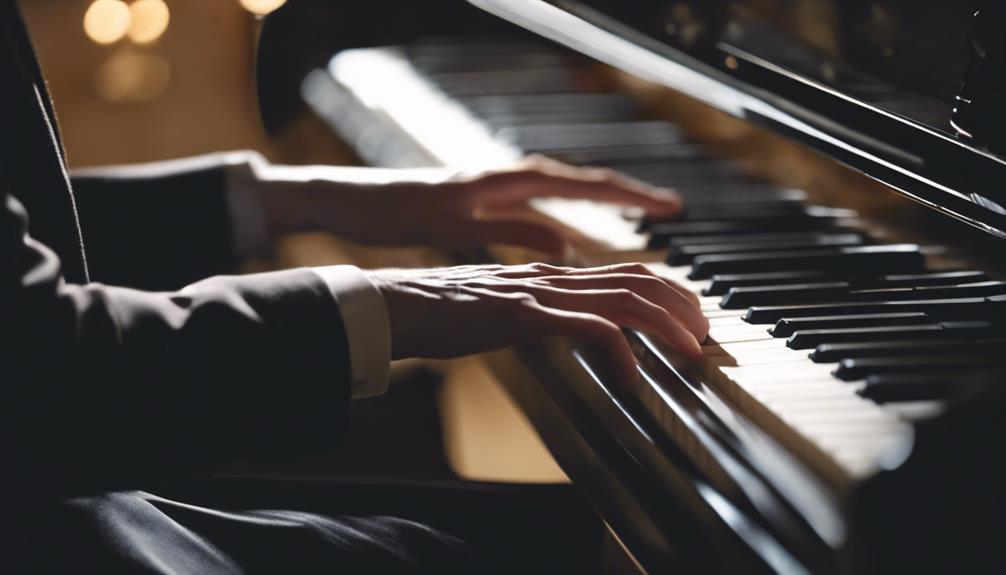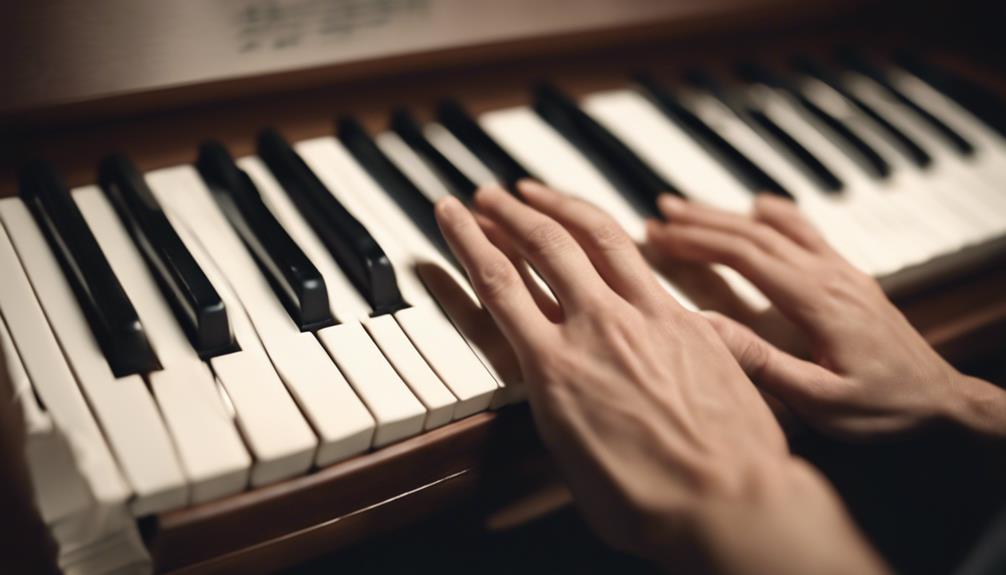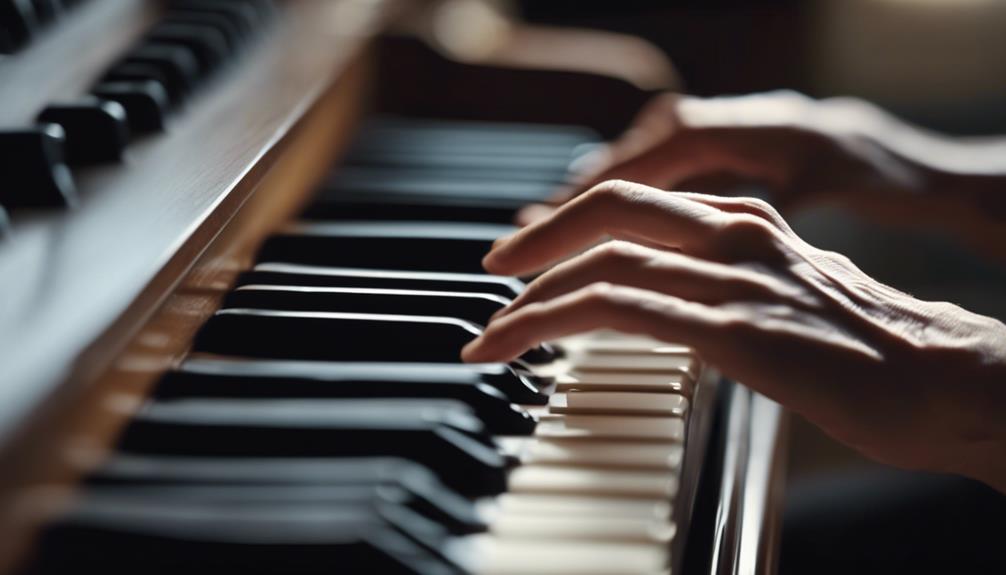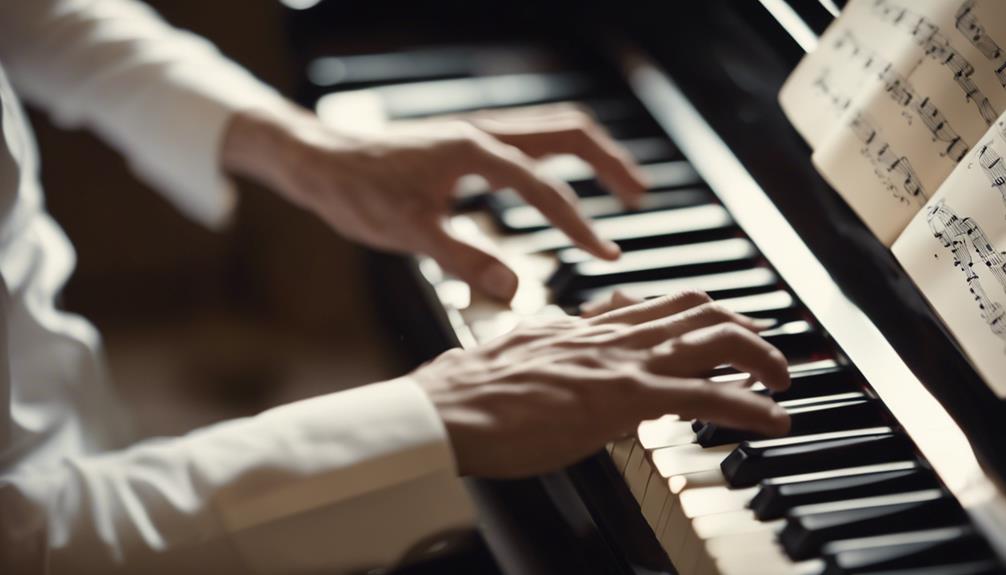When you’re learning to play piano arpeggios, it’s crucial to start with a solid understanding of the notation and proper fingerings for each pattern.
Begin with a relaxed hand position and curved fingers to guarantee fluid motion between notes. Focus initially on simple major triads to build muscle memory and a strong technical foundation.
Once you’re comfortable, gradually incorporate both hands to enhance coordination and independence. But how do you effectively increase the complexity of your practice, and what advanced techniques can elevate your arpeggio skills to the next level?
TL-DR
- Use proper fingerings like 1-2-3-5 or 1-2-4-5 for smooth and efficient arpeggio execution.
- Maintain a relaxed hand position with curved fingers and fluid wrist movements.
- Start practicing with simple major triads, such as the C major arpeggio, to build a solid foundation.
- Utilize a metronome to ensure consistent timing and gradually increase the tempo as proficiency improves.
- Practice arpeggios with both hands to develop coordination and hand independence.
Understanding Arpeggios

Arpeggios, often referred to as broken chords, are vital for adding depth and movement to your piano playing. When you play arpeggios, you’re basically performing each note of a chord separately rather than striking them all at once. This technique not only enriches the music but also helps you gain a deeper understanding of the chords you’re working with.
Mastering arpeggios requires dedication and practice. As you practice, you’ll notice improvements in hand strength and finger dexterity. Your hand will learn to move smoothly and accurately across the keys, which is important for maintaining the fluidity that arpeggios demand. Proper fingering plays a significant role here; without it, you might struggle to play arpeggios cleanly and efficiently.
Knowing how to play arpeggios also enhances your overall piano skills. It helps you better interpret and perform various pieces of music, as many compositions rely on arpeggios for their melodic and harmonic structure.
Arpeggio Notation
To accurately perform arpeggios, understanding their notation in sheet music is essential. Arpeggios in piano music are often notated with arrows that indicate the direction in which you should play. These arrows help you understand whether to play the notes ascending or descending, ensuring you follow the intended flow.
Another common notation method involves writing each individual note of the arpeggio separately. This approach gives you a clear view of each note in sequence, which is especially useful for complex arpeggio patterns. By reading each individual note, you can see the exact notes to play and their order, promoting accuracy in your performance.
Proper interpretation of arpeggio notation is vital. Whether you see arrows indicating direction or individual notes, your ability to read and understand these symbols directly affects how well you’ll execute the arpeggios. Different notation styles convey the order and flow of the arpeggio notes, guiding you to play them fluidly and correctly.
Benefits of Arpeggios

Mastering arpeggios greatly enhances your finger dexterity and hand coordination in piano playing. When you practice playing arpeggios regularly, you’ll notice a significant improvement in your overall technique in piano playing. The movement required to smoothly shift between notes helps you develop a more fluid and efficient hand movement, which is vital for tackling more complex pieces.
Playing arpeggios also improves your technical proficiency. By working on these patterns, you build strength and agility in your fingers, making it easier to navigate the keyboard with precision and speed. This technical skill is pivotal for any pianist looking to advance their playing abilities.
Moreover, understanding and practicing arpeggios enhances your knowledge of music theory. Arpeggios are essentially broken chords, and playing them helps you recognize chord structures and progressions, deepening your comprehension of harmony. This theoretical insight is invaluable, as it allows you to interpret and perform a wide variety of musical styles with greater confidence.
Incorporating arpeggios into your practice routine adds movement, fluidity, and richness to your music. Mastery of arpeggios not only expands your technical toolbox but also refines your skills as a musician, empowering you to play more expressively and dynamically.
Fingerings and Hand Position
When playing arpeggios, you’ll find that correct finger placement is vital for smooth shifts and accuracy.
By mastering hand movement techniques, you can guarantee fluidity and control across the keys.
Consistent practice with these elements will greatly enhance your proficiency and comfort while playing.
Proper Finger Placement
Correct finger placement is essential for playing piano arpeggios smoothly and efficiently. To start, you need to use proper fingering. Common fingerings include 1-2-3-5 or 1-2-4-5, depending on the specific arpeggio. This guarantees you can move through the notes fluidly without unnecessary strain. Maintaining a correct hand position is equally important. Your wrists should be relaxed, and your fingers should be curved. This setup facilitates smooth changes between notes.
Begin your arpeggio practice slowly to guarantee accurate finger placements and proper hand positions. As you build confidence, you can gradually increase the speed. Focus on the even distribution of weight across each finger. This approach helps prevent strain and fatigue, allowing you to play for longer periods without discomfort.
Regularly practicing finger exercises is also beneficial. These exercises strengthen your fingers and improve their flexibility, making it easier to handle the demands of playing arpeggios.
Consistent practice with proper finger placements and hand positioning will lead to smoother, more efficient playing. Remember, mastering arpeggios takes time, so be patient and persistent with your practice.
Hand Movement Techniques
Effective hand movement techniques, including proper fingerings and hand positioning, are essential for executing piano arpeggios with precision and fluidity. When playing arpeggios on the piano, your hand position should always be relaxed and aligned with the arpeggio pattern you’re working on. This alignment guarantees that your fingers can move smoothly across the keys without unnecessary tension.
Using the correct fingerings is pivotal for smooth progression between notes. Each type of arpeggio often has established fingerings that maximize efficiency and comfort. For instance, in a C major arpeggio, you’d typically use the 1-2-3-1-2-3-5 finger pattern for the right hand. These fingerings help maintain a balanced hand position, making your hand movements more consistent.
Practice techniques are essential for mastering arpeggios. Start by practicing slowly to focus on precision and fluidity. Pay attention to your hand movements, ensuring they’re controlled and deliberate. Gradually increase your speed as you become more comfortable with the fingerings and hand positioning.
Practicing Simple Patterns

When practicing simple patterns, start with major triads to build a strong foundation.
Use a metronome to keep a steady tempo and enhance your timing.
Incorporate both hands to improve coordination and create a fuller sound.
Start With Major Triads
Begin your piano arpeggio practice by mastering major triads, which are fundamental building blocks in music. Start with the C major arpeggio, as it consists only of white keys, making it an ideal introduction. Focus on proper hand position and finger placement to guarantee accuracy. When you’re playing, keep your fingers curved and relaxed, allowing for smooth shifts between notes.
To practice effectively, play the arpeggio in both ascending and descending patterns. This will help you build muscle memory and develop a strong foundation. Start slowly, paying close attention to each note and hand movement. As you become more comfortable, you can gradually increase your speed.
Here are some key steps to visualize:
- Place your right thumb on C: Your thumb will play the root note, with your third finger on E (major third) and fifth finger on G (perfect fifth).
- Ascend smoothly: As you move up the keyboard, make sure each note is clear and even.
- Descend carefully: When coming back down, maintain the same hand position and control.
Utilize Metronome Practice
Using a metronome helps you maintain a steady rhythm and improve your timing when practicing piano arpeggios. Start by setting the metronome at a comfortable tempo. This will make sure you can focus on playing each note accurately without feeling rushed.
Begin with simple arpeggio patterns, such as major triads, to get a solid foundation in your technique.
As you sync your playing with the metronome, you’ll notice improvements in both timing and precision. Metronome practice is vital because it forces you to play at a consistent pace, which is essential for developing accuracy.
Once you feel confident at a slower tempo, gradually increase the speed. This gradual increase allows you to build speed without sacrificing accuracy.
You can use the metronome to track your progress. Challenge yourself to play arpeggios faster and smoother, but always make sure that you’re maintaining a steady rhythm.
Practicing with a metronome not only enhances your sense of timing but also helps you develop a consistent arpeggio technique. Remember, the goal is to play cleanly and accurately, so don’t rush the process.
Consistent metronome practice will lead to significant improvements over time.
Incorporate Both Hands
Start by practicing simple arpeggio patterns with both hands to develop coordination and build muscle memory. Focus on playing arpeggios slowly and accurately at first, so you can get comfortable with the proper fingerings and changes. This approach helps you incorporate both hands in a vital way, which is important for achieving hand independence.
When you practice arpeggios, start with broken chords that are easy to manage. Gradually increase complexity as your skill improves.
Here are some tips to get you started:
- Slow and Steady: Play at a slow tempo to guarantee accuracy and smooth shifts.
- Proper Fingerings: Use correct fingerings for each hand to make the movements more fluid.
- Wrist Movements: Pay attention to your hand positioning and wrist motions to maintain fluidity.
Once you’re comfortable with simple patterns, try combining two different arpeggios in each hand. This will further enhance your hand independence and coordination.
Increasing Complexity
To enhance your arpeggio practice, delve into gradually increasing the tempo and introducing various patterns and inversions. Start by ensuring that chords are played cleanly and accurately at a slow pace. As you become more comfortable, challenge yourself to play faster arpeggios by incrementally increasing the tempo. Use a metronome to maintain a consistent speed and track your progress.
Next, explore diverse arpeggio patterns. Experiment with broken chords, where notes are played in a sequence rather than simultaneously. Incorporate different inversions to add depth and variety to your practice. An arpeggio in root position will sound different from its first or second inversion, offering new challenges and textures.
As you progress, investigate arpeggios in various keys and styles. This not only broadens your musical repertoire but also enhances your technical skills. Combine arpeggio exercises with scales and other drills to create a well-rounded practice routine.
Maintaining Rhythm

A metronome is your best ally in maintaining a steady rhythm while playing arpeggios. Start by setting the metronome to a comfortable tempo. As you play, focus on consistent timing between each note. This guarantees your arpeggios sound smooth and flowing, rather than rushed or uneven. Counting out loud while practicing helps you internalize the rhythmic structure, making it easier to stay on beat.
Pay attention to the duration of each note. Each note in the arpeggio should be given equal time, contributing to a balanced sound. By doing so, you develop a strong sense of pulse and timing, essential for accurate and expressive playing.
Here are some tips to visualize your practice:
- Imagine a steady pulse: Visualize the beats as a series of evenly spaced dots, guiding your fingers.
- Feel the rhythm in your body: Sway slightly or tap your foot to the beat to keep your entire body engaged.
- Listen to the metronome: Hear it as a collaborator, not just a tool, to synchronize your playing.
Using these techniques, you’ll find that maintaining rhythm in your arpeggios becomes second nature, enhancing both your technical skill and musical expressiveness.
Common Arpeggio Patterns
Exploring common arpeggio patterns can greatly enhance your piano playing technique and musicality. When you play one note after another in rapid succession, arpeggios create a flowing, melodic line. Let’s delve into some essential patterns.
The Crossover pattern is a great way to guarantee smooth shifts across the keyboard. By alternating hands, you maintain a consistent flow. For example, start with your Left Hand playing a lower octave and then cross over with your right to continue the arpeggio.
One useful pattern for the Left Hand is the Third on Top accompaniment. Here, your left hand plays arpeggios with the third note of the chord at the top, creating a rich harmonic base. This can be especially effective in slower pieces.
The Quick in the Left, Slow in the Right pattern helps develop hand independence. Your Left Hand plays arpeggios quickly while your right hand plays the same notes more slowly, creating an engaging contrast.
The Spa arpeggio pattern emphasizes relaxation and fluidity. Focus on staying relaxed and let each arpeggio flow naturally.
Lastly, structured practice routines like the Hallelujah and Clocks patterns offer specific chord progressions to master. These common arpeggio patterns will solidify your skills and build a strong foundation.
Advanced Techniques

Mastering advanced techniques will elevate your arpeggio playing to a professional level. To achieve this, you’ll need to incorporate several key strategies into your practice routine.
First, wrist rotation is pivotal for fluid arpeggio changes. By rotating your wrist, you can smoothly move between notes, reducing tension and increasing speed. Proper fingering is equally important. Each arpeggio pattern has an ideal fingering that maximizes efficiency and accuracy; familiarize yourself with these patterns to enhance your playing.
Hand independence exercises are another essential component. These exercises train each hand to operate independently, allowing you to maintain consistent tone and volume across complex arpeggio passages.
Experimenting with different tempos can greatly improve your arpeggio speed and accuracy. Start slow to guarantee precision, then gradually increase the tempo as you become more comfortable. This will help you play faster without sacrificing control.
In your practice sessions, focus on:
- Maintaining a consistent tone and volume throughout your arpeggios.
- Rotating your wrist for smooth changes between notes.
- Using proper fingering for each arpeggio pattern to enhance efficiency.
Next up, learn all about how to use piano pedals in this guide.
